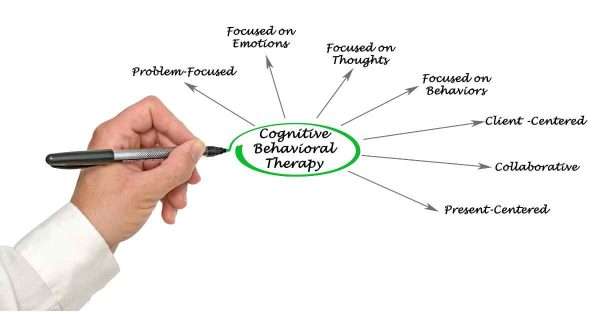Pain, both physical and emotional, is a universal human experience. While many treatments address the physical symptoms, Cognitive Behavioral Therapy (CBT) offers a holistic approach, targeting both the mind and body. Consider a person who, after a minor car accident, develops a fear of driving. While the physical pain from the accident heals, the emotional trauma remains, and CBT can help address both. By the end of the article, you’ll understand just how powerful CBT for pain relief can really be!
Understanding the CBT Framework

CBT recognizes that our thoughts, emotions, and behaviors are interconnected. Negative thought patterns can exacerbate pain perception, leading to emotional distress and unhelpful behaviors. For instance, a patient with chronic pain might think, “I’ll never be able to enjoy activities again.” This thought can lead to sadness and behaviors like avoiding social events, further reinforcing the negative thinking.
Historical Context of CBT
CBT’s roots trace back to the mid-20th century, evolving from behavioral therapy and cognitive therapy. Its application for pain management began gaining traction in the 1980s. In that era, studies observed that patients who underwent physical therapy and CBT for chronic pain had better outcomes than those who only received physical therapy.
The Science Behind CBT for Pain
- Brain Plasticity: CBT can influence the brain’s neural pathways, altering pain perception. After several CBT sessions, patients with migraines might find their pain less intense as their brain starts processing pain signals differently.
- Emotional Regulation: CBT diminishes emotional responses like anxiety, which can amplify pain. A person with arthritis might feel anxious about future pain, worsening their pain. CBT can help them manage this anxiety, indirectly reducing their pain.
- Behavioral Impact: CBT encourages behaviors that modulate pain, like relaxation techniques. Someone with fibromyalgia might learn deep breathing exercises in CBT, which they find helps reduce their pain during flare-ups.
Core Principles of CBT for Pain

- Cognitive Awareness: Recognizing and understanding negative thought patterns. A person might realize, “Every time I feel a twinge, I immediately think it’s going to be a bad pain day. I need to challenge that thought.”
- Cognitive Restructuring: Challenging and replacing unhelpful thoughts. Instead of thinking, “This pain will ruin my day,” one might learn to think, “I have tools to manage my pain.”
- Behavioral Activation: participating in activities that improve mood and reduce pain. “Even though I’m in pain, I’ll take a short walk. Last time I did that, I felt better.”
- Skills Training: Learning techniques to manage and reduce pain. “I’ll practice the deep breathing exercises my therapist showed me every time I feel overwhelmed by pain.”
Benefits of CBT for Pain
- Empowerment: Strengthening belief in one’s ability to manage pain. “I used to feel helpless against my pain, but after CBT, I feel like I have some control.”
- Improved Sleep: Addressing pain-related sleep disturbances. “I’ve started using the relaxation techniques I learned in CBT before bed, and I’m sleeping better, even on bad pain days.”
- Emotional Well-being: Reducing depression, anxiety, and stress linked to chronic pain. “I still have pain but don’t feel as anxious about it. I know I have strategies to cope.”
- Reduced Medication: Potentially decreasing dependence on pain medications. “After starting CBT, I’ve noticed I don’t need painkillers as often.”
Finding CBT Therapy for Pain Management
Exploring the world of therapy can be daunting, especially when you’re in pain. However, finding the right resources and professionals can make a large difference in your journey to pain relief. Here’s a guide to help you find the best CBT therapy for pain management:
Note: you can get CBT from your doctor’s office in the form of in person classes, or you can find self-study books online to do at home yourself.
- Consult with a Primary Care Physician or Specialist:
- Discuss your pain and interest in CBT with your primary care doctor or pain specialist. They can provide referrals to certified therapists or clinics specializing in pain management using CBT.
- Questions to ask: “Do you have recommendations for CBT therapists who specialize in pain management?” or “Are there any pain clinics in the area that offer CBT as part of their treatment approach?”
- Top-Rated Books on CBT for Pain:
- Cognitive Behavior Therapy: Basics and Beyond by Judith S. Beck
This book is a classic resource for anyone seeking a comprehensive understanding of CBT. It provides a well-organized and insightful overview of CBT principles and techniques.
This workbook is part of the “Treatments That Work” series and offers practical techniques and exercises for managing chronic pain using CBT.
This article provides a list of some of the best CBT books for self-help solutions and mental health techniques.
Safety and Considerations
While CBT is generally safe, it’s essential to ensure the therapy is tailored to individual needs. It’s not a one-size-fits-all approach, and what works for one person might not work for another. For instance, while one person might find journaling about their pain helpful, another might find it makes them focus too much on their pain.
Conclusion
CBT for pain offers a holistic approach to pain management, addressing pain’s physical and psychological components. With its deep-rooted historical significance and many modern-day applications, it is a testament to the symbiotic relationship between humans and therapeutic practices. From alleviating pain to rejuvenating the mind, its multifaceted benefits are a beacon of hope for those seeking holistic remedies. As we continue to explore and appreciate the wonders of CBT, it’s imperative to approach its use with knowledge and respect, ensuring it complements your journey to optimal health.
More Stories
Find more stories on the blog!
References:
- Neuroimaging Mechanism of Cognitive Behavioral Therapy in Pain Management
- Evaluation of Cognitive Behavioral Therapy on Improving Pain, Fear Avoidance, and Self-Efficacy in Patients with Chronic Low Back Pain: A Systematic Review and Meta-Analysis
- Comparison of a Single-Session Pain Management Skills Intervention With a Single-Session Health Education Intervention and 8 Sessions of Cognitive Behavioral Therapy in Adults With Chronic Low Back Pain




